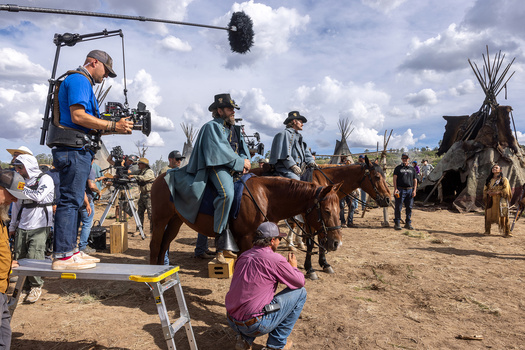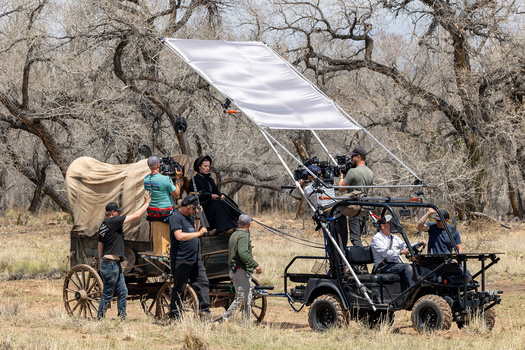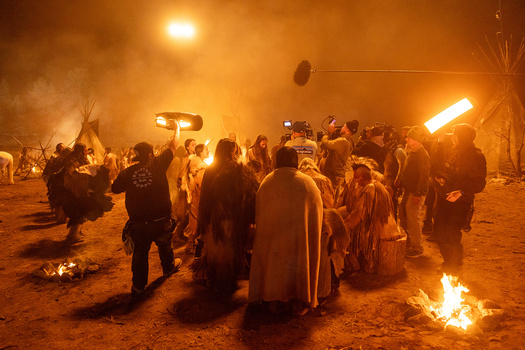In my previous article, I already waxed lyrical about its inspiring cinematography, but for anybody not familiar with this show, I’ll provide a little background. Set in the American West in the year 1857, this Netflix Original miniseries of six episodes follows the story of Sara and her son Devin as they confront the dangers and hardships of the wild and lawless frontier territories on their journey out West, where they hope to reunite with family. In addition to the harsh and unforgiving terrain they must cross, they will find themselves in the midst of a bloody conflict between warring factions of Native Americans, Mormon militias, and U.S. federal soldiers, all locked in a brutal struggle for control of the territory.
Written by Mark L. Smith, who also wrote The Revenant, and directed by Peter Berg, American Primeval is both visually stunning and a masterful piece of storytelling. If it looks more like a movie than television, that’s because it was shot like a movie. In fact, in this golden age of television, the line between the “big screen” and the “small screen” has been significantly blurred, with the composition of the crew and the equipment deployed on set being largely the same, whether the production is initially destined for theaters or your television screen.
Like every movie set, the crew of American Primeval included a unit still photographer whose job is effectively to tell in still pictures not only the story of the movie but also the story of the making of the movie. Whenever you see movie posters, promotional stills for a new movie, or behind-the-scenes photographs featured in articles and videos about the making of the movie, chances are they were captured by the unit still photographer.
The unit still photographer for American Primeval was Matt Kennedy, an industry veteran with some three decades of experience working on film sets. To understand how he came to be hired to this highly sought-after position, you need only look at his incredible portfolio of work on previous productions such as Black Panther, and movies from the Star Wars and Marvel franchises. For this article, Matt has very kindly agreed to share with us his experience of what it was like behind the scenes working on this amazing production, what it takes to build a successful career as a unit still photographer, and a selection of his personal favorites from the incredible collection of photographs he captured on the set of American Primeval.
The work of a unit still photographer falls into the genre that might broadly be referred to as production photography—and while other genres like sports, wedding, portrait, and commercial photography are more widely recognized as career paths, there is a smaller, specialized group of professionals like Matt who build very successful and rewarding careers in production photography. Matt got his start in the film industry in the 1990s, working on the moving-picture side of filmmaking as an assistant cameraman. Still photography, however, was always a big part of Matt’s life growing up, and driven by the urge to pursue a creative career in photography, he made what would turn out to be a very fortuitous lateral move from moving pictures to still images, eventually establishing himself as one of the movie industry’s leading unit still photographers.Even though Matt already had more than a decade of experience in the film industry at that point in his career, as well as an extensive network of industry contacts, the transition was nonetheless quite a difficult one.
It wasn’t easy. It took me quite a few years to build a portfolio and reestablish myself in the industry as a unit photographer.
Matt’s experience echoes a common issue encountered by most creatives early in their careers—establishing yourself in any kind of creative field takes perseverance and a (typically) largely unrewarding period of dedication to building a body of work before your work is ever going to bring you any kind of recognition or financial compensation. Like virtually all creatives who are at the top of their game, the path from where Matt started out was not a short or easy one.
To be a successful unit still photographer, mastery of the photographic process and a high degree of artistry with the camera are a given, but I was curious what other attributes are important for somebody in this role or who aspires to pursue it as a career.
Understanding how a film set works and how you fit into that is really crucial… there’s a lot of people and a lot of moving parts.
On a big production like American Primeval, there are a lot of people working behind the scenes, engaged in a plethora of different activities. When Matt started out as a unit still photographer, he was fortunate insofar as his decade of experience working as an assistant cameraman had already given him an excellent working knowledge of how a film set functions. A big part of a unit still photographer’s skill set is being able to navigate the frantic activity of a shooting location, knowing how to be in the right place at the right time to get the shot, without being in anybody’s way or stepping on other people’s toes.
Working in such a tight-knit group also demands another very important skill: the ability to build good relationships.
You need to have really good working relationships with the entire crew because you spend so much time together in such tight quarters.
Developing some kind of rapport with the actors in a production is also essential for a unit still photographer, since a lot of time will be spent up close and personal, photographing them on set. In portrait photography, this ability is arguably what separates a good portrait photographer from a great one.
To make sure [the actors] are comfortable with you is key, because you’ll get the best images.
Surprisingly, photographing the actors on set can sometimes be trickier than you might imagine. I was very surprised to learn from Matt that some actors find it far easier to be in front of a movie camera than in front of a still camera.
American Primeval was shot in several locations around Sante Fe in New Mexico, and the stunning natural beauty of the region plays a really big part in the show, especially since almost every scene in the nearly six hours of the story takes place outdoors. This naturally imposes an additional overhead in preparation and logistics for a film production, especially given the vicissitudes of the New Mexico weather and the extreme altitudes of some of the locations. Safety is of paramount importance on a film set, and for some shooting locations at high altitude for example, bottled oxygen was even made available to the cast and crew between takes, to help them catch their breath again if they needed it.As strange as it sounds, there are some actors that are not comfortable with the still camera. You can have ten movie cameras [on them] but they’re just not comfortable with a still camera on set. This was not the case however on American Primeval. Our cast was amazing. They allowed me full access and their trust, and that's all I can ask and hope for!
Yeah, it could be really tough. I don’t know if you’ve ever been to New Mexico, but you can have four seasons in one day… so that was a challenge. We shot in every kind of weather from snowstorms to one hundred degree heat.
One of central and recurring locations in American Primeval is the historic Fort Bridger, a frontier trading post established in the 1800s in what is now Wyoming, by mountain man and trapper Jim Bridger. Such was the director Peter Berg’s commitment to detail and authenticity, that he had this iconic location accurately recreated using only the tools that would have been available to Bridger and his men at that time—no small feat since Fort Bridger was essentially a small town. Furthermore, it was not to be built in the old Hollywood style in which you create the illusion of a wild west town by using a row of thin, wooden facades hung on a supporting framework. Peter Berg wanted Fort Bridger recreated in its entirety, so that he could give the audience of American Primeval an authentic sense of how the place would have looked and felt, inside and out.
The way that Pete [Berg] likes to shoot is that he wants to be able to put the camera anywhere at any time, and so everything needs to be screen-ready. It was not like a facade where you can only shoot it from one direction. It was very immersive, to where the cameras could go in and out … and you see every bit of it.
For his still photography work on American Primeval, Matt used Canon R5 and R6 bodies, paired with Canon RF lenses - particularly the Canon RF 24-70mm f/2.8 and Canon RF 70-200mm f/2.8. He also used the Canon RF 100-500mm f/4.5-7.1 for some of the longer shots—mainly for scenes in which the actors were on horseback. Although he did also use one or two of the Canon RF primes occasionally, the 24-70mm and 70-200mm are generally considered the go-to zoom lenses for most unit still photographers since they afford them the speed and flexibility that they need for composing shots quickly in response to the rapidly evolving action on set.
As a unit photographer, you kind of claim your place on set for a shot, and in my experience, everything can change at the last minute before we roll, and if I have to adjust [the focal length], a couple of millimeters, you can’t do that on a prime obviously, and I can’t just get up and move. It’s just easier to adjust on the fly with zoom lenses.
The rigors of shooting outdoors over several months—sometimes at extreme altitudes above 11,000 feet, and in all kinds of weather that included high winds, dust, rain, and snow—also took its toll on the cameras and lenses.
The gear just took a beating. When I was done with Primeval, Canon had to take my lenses apart and replace some of the elements, because there was so much stuff that got in through the weather seals.
Despite all of the rigors of the shoot, Matt thoroughly enjoyed his time working on the set of American Primeval, and it was an experience that he will never forget. I’m very grateful to Matt for giving us his time to share some of that experience with us, for giving us a peek behind the scenes at what goes into creating an amazing work of motion picture art, and for sharing his stunning photography with us. I would also like to thank Netflix for granting us the permission to use these images in our article.
American Primeval is available to watch now on Netflix.
Images provided by Netflix.






















"As strange as it sounds, there are some actors that are not comfortable with the still camera."
This is surprisingly true. I worked productions for HBO and Universal in the 90's and 2000's. There was a very famous male star who absolutely hated having still cameras on set which confused me greatly. I spent most of the time trying to stay out of his eye line. He yelled at me more than once but the producer would swoop in and soften his mood.
On a related note… it would have been a lot more inconspicuous to have had an electronic shutter in a mirrorless body back then. We had these very large sound blimps over the camera… almost impossible to remain invisible.
I accidentally stumbled onto American Primeval on Netflix a couple months ago. Once you start watching it, you can't stop. The cinema photography makes you feel like you're actually in the scene. Photographers will really appreciate the camera work.